

Compact Muon Solenoid
LHC, CERN
| CMS-HIG-18-006 ; CERN-EP-2019-105 | ||
| Search for light pseudoscalar boson pairs produced from decays of the 125 GeV Higgs boson in final states with two muons and two nearby tracks in pp collisions at $\sqrt{s} = $ 13 TeV | ||
| CMS Collaboration | ||
| 16 July 2019 | ||
| Phys. Lett. B 800 (2019) 135087 | ||
| Abstract: A search is presented for pairs of light pseudoscalar bosons, in the mass range from 4 to 15 GeV, produced from decays of the 125 GeV Higgs boson. The decay modes considered are final states that arise when one of the pseudoscalars decays to a pair of tau leptons, and the other one either into a pair of tau leptons or muons. The search is based on proton-proton collisions collected by the CMS experiment in 2016 at a center-of-mass energy of 13 TeV that correspond to an integrated luminosity of 35.9 fb$^{-1}$. The 2$\mu$ 2$\tau$ and 4$\tau$ channels are used in combination to constrain the product of the Higgs boson production cross section and the branching fraction into 4$\tau$ final state, ${\sigma \mathcal{B}}$, exploiting the linear dependence of the fermionic coupling strength of pseudoscalar bosons on the fermion mass. No significant excess is observed beyond the expectation from the standard model. The observed and expected upper limits at 95% confidence level on ${\sigma \mathcal{B}}$, relative to the standard model Higgs boson production cross section, are set respectively between 0.022 and 0.23 and between 0.027 and 0.19 in the mass range probed by the analysis. | ||
| Links: e-print arXiv:1907.07235 [hep-ex] (PDF) ; CDS record ; inSPIRE record ; HepData record ; CADI line (restricted) ; | ||
| Figures | |

png pdf |
Figure 1:
Illustration of the signal topology, in which the H decays into two $\mathrm{a}_{1}$ bosons, where one $\mathrm{a}_{1}$ boson decays into a pair of tau leptons, while the other one decays into a pair of muons or a pair of tau leptons. The analyzed final state consists of one muon and an oppositely charged track in each $\mathrm{a}_{1}$ decay. |

png pdf |
Figure 2:
Binning of the 2D ($m_1,m_2$) distribution. |
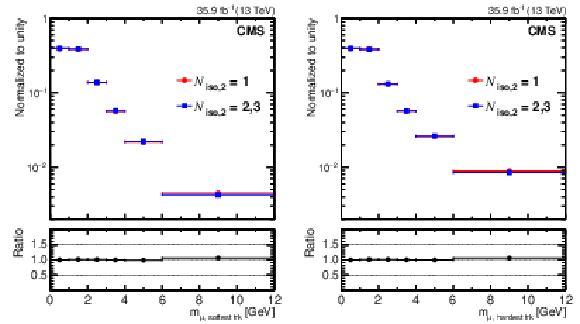
png pdf |
Figure 3:
The observed invariant mass distribution, normalized to unity, of the first muon and the softest (left) or hardest (right) accompanying "signal" track for different isolation requirements imposed on the second muon: when the second muon has only one accompanying "isolation" track ($N_\text {iso,2}=1$; circles); or when it has two or three accompanying "isolation" tracks ($N_\text {iso,2}=2,3$; squares). |
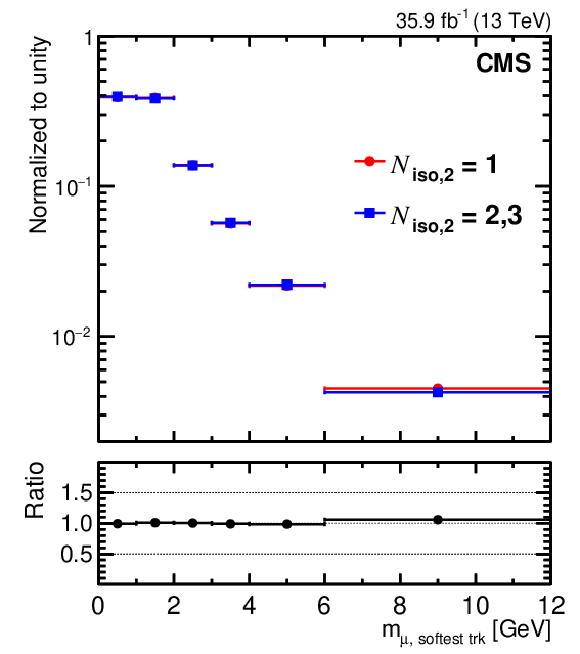
png pdf |
Figure 3-a:
The observed invariant mass distribution, normalized to unity, of the first muon and the softest accompanying "signal" track for different isolation requirements imposed on the second muon: when the second muon has only one accompanying "isolation" track ($N_\text {iso,2}=1$; circles); or when it has two or three accompanying "isolation" tracks ($N_\text {iso,2}=2,3$; squares). |
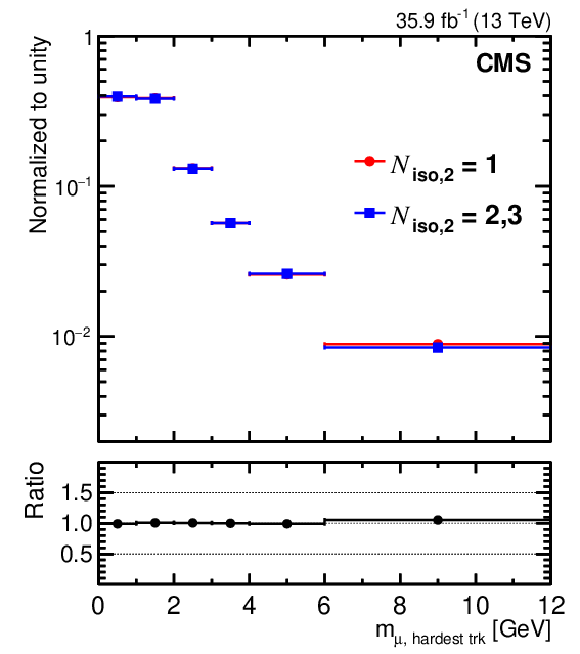
png pdf |
Figure 3-b:
The observed invariant mass distribution, normalized to unity, of the first muon and the hardest accompanying "signal" track for different isolation requirements imposed on the second muon: when the second muon has only one accompanying "isolation" track ($N_\text {iso,2}=1$; circles); or when it has two or three accompanying "isolation" tracks ($N_\text {iso,2}=2,3$; squares). |

png pdf |
Figure 4:
The observed invariant mass distribution, normalized to unity, of the muon-track invariant mass in control regions $N_{23}$ (circles) and $N_{45}$ (squares). |
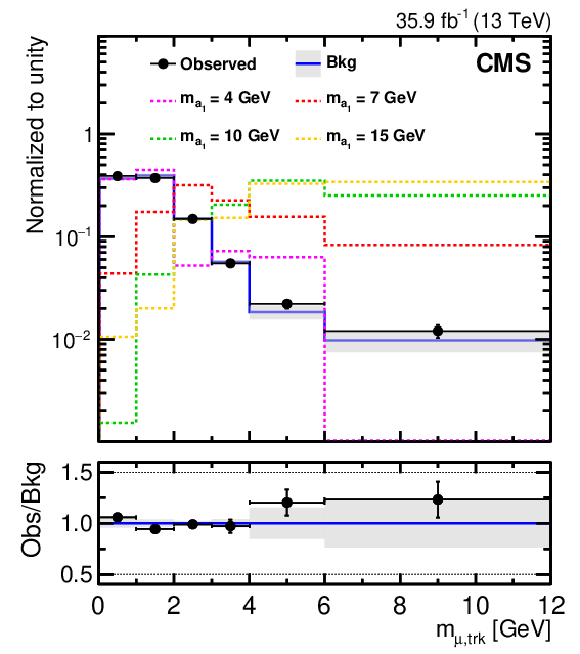
png pdf |
Figure 5:
Normalized invariant mass distribution of the muon-track system for events passing the signal selection. Observed numbers of events are represented by data points with error bars. The QCD multijet background model is derived from the control region $N_{23}$. Also shown are the normalized distributions from signal simulations for four mass hypotheses, $m_{\mathrm{a}_{1}}=$ 4, 7, 10, and 15 GeV (dashed histograms), whereas for higher masses the analysis has no sensitivity. Each event in the observed and expected signal distributions contributes two entries, corresponding to the two muon-track systems in each event passing the selection. The signal distributions include 2$\mu $2$\tau $ and 4$\tau $ contributions. The lower panel shows the ratio of the observed to expected number of background events in each bin of the distribution. The grey shaded area represents the background model uncertainty. |
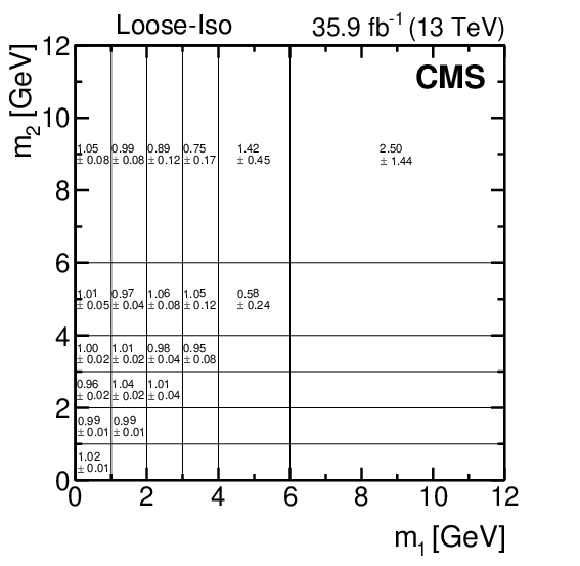
png pdf |
Figure 6:
The ($m_1,m_2$) correlation factors $C(i,j)$ with their statistical uncertainties, derived from data in the CR {{Loose-Iso}}. |
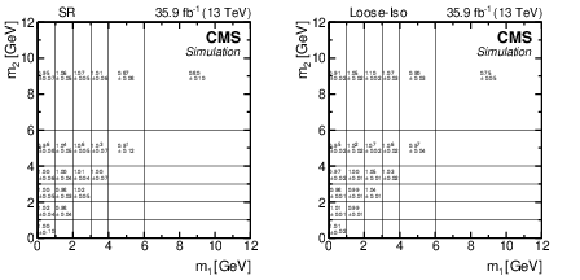
png pdf |
Figure 7:
The ($m_1,m_2$) correlation factors $C(i,j)$ along with their MC statistical uncertainties, derived from simulated samples in the (left: signal region, right: Loose-Iso CR). |

png pdf |
Figure 7-a:
The ($m_1,m_2$) correlation factors $C(i,j)$ along with their MC statistical uncertainties, derived from simulated samples in the signal region. |

png pdf |
Figure 7-b:
The ($m_1,m_2$) correlation factors $C(i,j)$ along with their MC statistical uncertainties, derived from simulated samples in the Loose-Iso CR. |

png pdf |
Figure 8:
The distribution of the signal templates $f_\text {2D}(i,j)$ in one row for mass hypothesis $m_{\mathrm{a}_{1}} = $ 4 GeV (left) and 10 GeV (right). The $\mathrm{H} \to \mathrm{a}_{1} \mathrm{a}_{1} \to 2\mu 2\tau $ (blue histogram) and $\mathrm{H} \to \mathrm{a}_{1} \mathrm{a}_{1} \to 4\tau $ (red histogram) contributions are shown. The notation of the bins follows that of Fig. 2. |
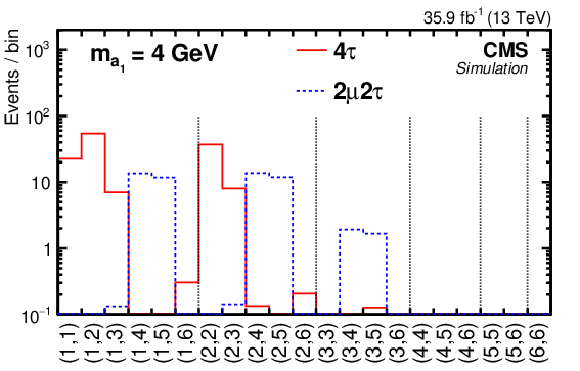
png pdf |
Figure 8-a:
The distribution of the signal templates $f_\text {2D}(i,j)$ in one row for mass hypothesis $m_{\mathrm{a}_{1}} = $ 4 GeV. The $\mathrm{H} \to \mathrm{a}_{1} \mathrm{a}_{1} \to 2\mu 2\tau $ (blue histogram) and $\mathrm{H} \to \mathrm{a}_{1} \mathrm{a}_{1} \to 4\tau $ (red histogram) contributions are shown. The notation of the bins follows that of Fig. 2. |
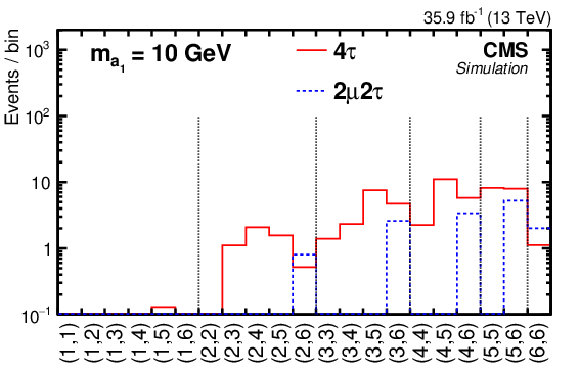
png pdf |
Figure 8-b:
The distribution of the signal templates $f_\text {2D}(i,j)$ in one row for mass hypothesis $m_{\mathrm{a}_{1}} = $ 10 GeV. The $\mathrm{H} \to \mathrm{a}_{1} \mathrm{a}_{1} \to 2\mu 2\tau $ (blue histogram) and $\mathrm{H} \to \mathrm{a}_{1} \mathrm{a}_{1} \to 4\tau $ (red histogram) contributions are shown. The notation of the bins follows that of Fig. 2. |
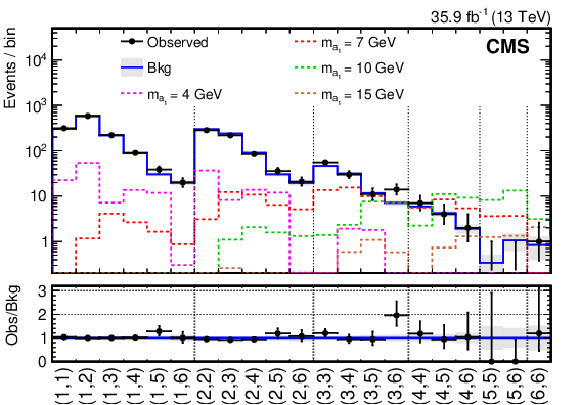
png pdf |
Figure 9:
The ($m_1,m_2$) in one row distribution used to extract the signal. Observed numbers of events are represented by data points with error bars. The background with its uncertainty is shown as the blue histogram with the shaded error band. The shape and the normalization of the background distribution are obtained by applying a fit to the observed data under the background-only hypothesis. Signal expectations for the 4$ \tau $ and 2$\mu $2$\tau $ final states are shown as dotted histograms for the mass hypotheses $m_{\mathrm{a}_{1}}=$ 4, 7, 10 and 15 GeV. The relative normalisation of the 4$ \tau $ and 2$\mu $2$\tau $ final states are given by Eq. (1) as explained in Section 6. The signal normalization is computed assuming that the H boson is produced in pp collisions with a rate predicted by the SM, and decays into $ \mathrm{a}_{1} \mathrm{a}_{1} \to 4\tau $ final state with the branching fraction of 20%. The lower plot shows the ratio of the observed data events to the expected background yield in each bin of the ($m_1,m_2$) distribution. |

png pdf |
Figure 10:
The observed and expected upper limits at 95% confidence levels on the product of signal cross section and the branching fraction $\sigma ({\mathrm{p}} {\mathrm{p}} \to \mathrm{H} +X) {\mathcal {B}} (\mathrm{H} \to \mathrm{a}_{1} \mathrm{a}_{1}) {\mathcal {B}}^{2} (\mathrm{a}_{1} \to \tau \tau)$, relative to the inclusive Higgs boson production cross section $\sigma _\text {SM}$ predicted in the SM. The green and yellow bands indicate the regions that contain 68% and 95% of the distribution of limits expected under the background-only hypothesis. The shaded area in blue indicates the excluded region of $ > $34% for the branching fraction of the H decay into non-SM particles at 95% CL from Ref. [26]. |
| Tables | |

png pdf |
Table 1:
The signal acceptance and the number of expected signal events after selection in the SR. The number of expected signal events is computed for a benchmark value of branching fraction, ${\mathcal {B}}(\mathrm{H} \to \mathrm{a}_{1} \mathrm{a}_{1}) {\mathcal {B}}^{2} (\mathrm{a}_{1} \to \tau \tau)=0.2$ and assuming that the H production cross section is the one predicted in the SM. The quoted uncertainties for predictions from simulation include only statistical ones. |

png pdf |
Table 2:
Control regions used to construct and validate the background model. The symbols $N_\text {sig}$, $N_\text {iso}$ and $N_\text {soft}$ denote the number of "signal", "isolation" and "soft" tracks, respectively, within a cone of $\Delta \mathrm {R}=0.5$ around the muon momentum direction. The last row defines the SR. |
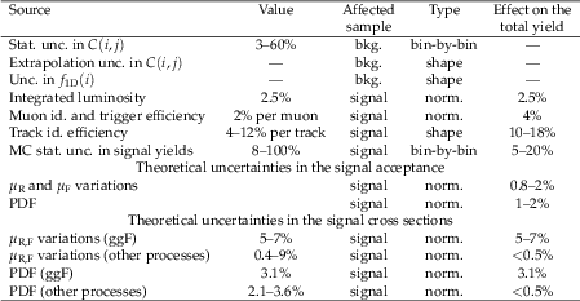
png pdf |
Table 3:
Systematic uncertainties and their effect on the estimates of the QCD multijet background and signal. |
| Summary |
| A search is presented for light pseudoscalar $ \mathrm{a}_1 $ bosons, produced from decays of the 125 GeV Higgs boson (H) in a data set corresponding to an integrated luminosity of 35.9 fb$^{-1}$ of proton-proton collisions at a center-of-mass energy of 13 TeV. The analysis is based on the H inclusive production and targets the $\mathrm{H}\to \mathrm{a}_{1} \mathrm{a}_{1} \to 4\tau/2\mu 2\tau$ decay channels. Both channels are used in combination to constrain the product of the inclusive signal production cross section and the branching fraction into the 4$\tau$ final state, exploiting the linear dependence of the fermionic coupling strength of $ \mathrm{a}_1 $ on the fermion mass. With no evidence for a signal, the observed 95% confidence level upper limit on the product of the inclusive signal cross section and the branching fraction, relative to the SM H production cross section, ranges from 0.022 at $m_{\mathrm{a}_{1} }=$ 9 GeV to 0.23 at $m_{\mathrm{a}_{1} }=$ 4 GeV and reaches 0.16 at $m_{\mathrm{a}_{1} }=15$ GeV. The expected upper limit ranges from 0.027 at $m_{\mathrm{a}_{1} }=$ 9 GeV to 0.16 at $m_{\mathrm{a}_{1} }=$ 4 GeV and reaches 0.19 at $m_{\mathrm{a}_{1} }=15$ GeV. |
| References | ||||
| 1 | ATLAS Collaboration | Observation of a new particle in the search for the standard model Higgs boson with the ATLAS detector at the LHC | PLB 716 (2012) 1 | 1207.7214 |
| 2 | CMS Collaboration | Observation of a new boson at a mass of 125 GeV with the CMS experiment at the LHC | PLB 716 (2012) 30 | CMS-HIG-12-028 1207.7235 |
| 3 | P. Fayet | Supergauge invariant extension of the Higgs mechanism and a model for the electron and its neutrino | NPB 90 (1975) 104 | |
| 4 | R. K. Kaul and P. Majumdar | Cancellation of quadratically divergent mass corrections in globally supersymmetric spontaneously broken gauge theories | NPB 199 (1982) 36 | |
| 5 | R. Barbieri, S. Ferrara, and C. A. Savoy | Gauge models with spontaneously broken local supersymmetry | PLB 119 (1982) 343 | |
| 6 | H. P. Nilles, M. Srednicki, and D. Wyler | Weak interaction breakdown induced by supergravity | PLB 120 (1983) 346 | |
| 7 | J.-M. Frere, D. R. T. Jones, and S. Raby | Fermion masses and induction of the weak scale by supergravity | NPB 222 (1983) 11 | |
| 8 | J.-P. Derendinger and C. A. Savoy | Quantum effects and SU(2)$ \times $U(1) breaking in supergravity gauge theories | NPB 237 (1984) 307 | |
| 9 | U. Ellwanger, C. Hugonie, and A. M. Teixeira | The next-to-minimal supersymmetric standard model | PR 496 (2010) 1 | 0910.1785 |
| 10 | M. Maniatis | The next-to-minimal supersymmetric extension of the standard model reviewed | Int. J. Mod. Phys. A 25 (2010) 3505 | 0906.0777 |
| 11 | J. E. Kim and H. P. Nilles | The $ \mu $-problem and the strong CP-problem | PLB 138 (1984) 150 | |
| 12 | G. Belanger et al. | Higgs bosons at 98 and 125 GeV at LEP and the LHC | JHEP 01 (2013) 069 | 1210.1976 |
| 13 | G. Belanger et al. | Two Higgs bosons at the Tevatron and the LHC? | 1208.4952 | |
| 14 | J. F. Gunion, Y. Jiang, and S. Kraml | Diagnosing degenerate Higgs bosons at 125 GeV | PRL 110 (2013) 051801 | 1208.1817 |
| 15 | J. F. Gunion, Y. Jiang, and S. Kraml | Could two NMSSM Higgs bosons be present near 125 GeV? | PRD 86 (2012) 071702 | 1207.1545 |
| 16 | S. F. King, M. Muhlleitner, and R. Nevzorov | NMSSM Higgs benchmarks near 125 GeV | NPB 860 (2012) 207 | 1201.2671 |
| 17 | S. F. King, M. Muhlleitner, R. Nevzorov, and K. Walz | Natural NMSSM Higgs bosons | NPB 870 (2013) 323 | 1211.5074 |
| 18 | U. Ellwanger, J. F. Gunion, and C. Hugonie | Difficult scenarios for NMSSM Higgs discovery at the LHC | JHEP 07 (2005) 041 | hep-ph/0503203 |
| 19 | U. Ellwanger, J. F. Gunion, C. Hugonie, and S. Moretti | Towards a no-lose theorem for NMSSM Higgs discovery at the LHC | in Physics at TeV colliders, Les Houches workshop 2003 | hep-ph/0305109 |
| 20 | U. Ellwanger, J. F. Gunion, C. Hugonie, and S. Moretti | NMSSM Higgs discovery at the LHC | in Physics at TeV colliders, Les Houches workshop 2003 | hep-ph/0401228 |
| 21 | A. Belyaev et al. | The scope of the 4 tau channel in Higgs-strahlung and vector boson fusion for the NMSSM no-Lose Theorem at the LHC | 0805.3505 | |
| 22 | A. Belyaev et al. | LHC discovery potential of the lightest NMSSM Higgs boson in the $ h_1 \to a_1 a_1 \rightarrow 4 \mu $ channel | PRD 81 (2010) 075021 | 1002.1956 |
| 23 | M. Lisanti and J. G. Wacker | Discovering the Higgs boson with low mass muon pairs | PRD 79 (2010) 115006 | 0903.1377 |
| 24 | M. M. Almarashi and S. Moretti | Scope of Higgs production in association with a bottom quark pair in probing the Higgs sector of the NMSSM at the LHC | 1205.1683 | |
| 25 | M. M. Almarashi and S. Moretti | LHC signals of a heavy CP-even Higgs boson in the NMSSM via decays into a $ Z $ and a light CP-odd Higgs state | PRD 85 (2012) 017701 | 1109.1735 |
| 26 | ATLAS and CMS Collaborations | Measurements of the Higgs boson production and decay rates and constraints on its couplings from a combined ATLAS and CMS analysis of the LHC pp collision data at $ \sqrt{s}= $ 7 and 8 TeV | JHEP 08 (2016) 045 | 1606.02266 |
| 27 | CMS Collaboration | Search for light bosons in decays of the 125 GeV Higgs boson in proton-proton collisions at $ \sqrt{s}= $ 8 TeV | JHEP 10 (2017) 076 | CMS-HIG-16-015 1701.02032 |
| 28 | CMS Collaboration | Search for a very light NMSSM Higgs boson produced in decays of the 125 GeV scalar boson and decaying into $ \tau $ leptons in pp collisions at $ \sqrt{s}= $ 8 TeV | JHEP 01 (2016) 079 | CMS-HIG-14-019 1510.06534 |
| 29 | CMS Collaboration | A search for pair production of new light bosons decaying into muons | PLB 752 (2016) 146 | CMS-HIG-13-010 1506.00424 |
| 30 | CMS Collaboration | Search for an exotic decay of the Higgs boson to a pair of light pseudoscalars in the final state of two muons and two $ \tau $ leptons in proton-proton collisions at $ \sqrt{s}= $ 13 TeV | JHEP 11 (2018) 018 | CMS-HIG-17-029 1805.04865 |
| 31 | CMS Collaboration | Search for an exotic decay of the Higgs boson to a pair of light pseudoscalars in the final state with two b quarks and two $ \tau $ leptons in proton-proton collisions at $ \sqrt{s}= $ 13 TeV | PLB 785 (2018) 462 | CMS-HIG-17-024 1805.10191 |
| 32 | ATLAS Collaboration | Search for the Higgs boson produced in association with a W boson and decaying to four $ b $-quarks via two spin-zero particles in pp collisions at 13 TeV with the ATLAS detector | EPJC 76 (2016) 605 | 1606.08391 |
| 33 | ATLAS Collaboration | Search for new light gauge bosons in Higgs boson decays to four-lepton final states in pp collisions at $ \sqrt{s}= $ 8 TeV with the ATLAS detector at the LHC | PRD 92 (2015) 092001 | 1505.07645 |
| 34 | ATLAS Collaboration | Search for new phenomena in events with at least three photons collected in pp collisions at $ \sqrt{s}= $ 8 TeV with the ATLAS detector | EPJC 76 (2016) 210 | 1509.05051 |
| 35 | ATLAS Collaboration | Search for Higgs bosons decaying to $ aa $ in the $ {\mu} {\mu} {\tau} {\tau} $ final state in $ pp $ collisions at $ \sqrt{s}=8\text{}\text{}\mathrm{TeV} $ with the ATLAS experiment | PRD 92 (2015) 052002 | 1505.01609 |
| 36 | ATLAS Collaboration | Search for Higgs boson decays into pairs of light (pseudo)scalar particles in the $ \gamma\gamma jj $ final state in $ pp $ collisions at $ \sqrt{s}= $ 13 TeV with the ATLAS detector | PLB 782 (2018) 750 | 1803.11145 |
| 37 | ATLAS Collaboration | Search for Higgs boson decays to beyond-the-standard-model light bosons in four-lepton events with the ATLAS detector at $ \sqrt{s}= $ 13 TeV | JHEP 06 (2018) 166 | 1802.03388 |
| 38 | CMS Collaboration | Search for an exotic decay of the Higgs boson to a pair of light pseudoscalars in the final state with two muons and two b quarks in pp collisions at 13 TeV | PLB 795 (2019) 398 | CMS-HIG-18-011 1812.06359 |
| 39 | CMS Collaboration | A search for pair production of new light bosons decaying into muons in proton-proton collisions at 13 TeV | Accepted by PLB (2018) | CMS-HIG-18-003 1812.00380 |
| 40 | D. Curtin et al. | Exotic decays of the 125 GeV Higgs boson | PRD 90 (2014) 075004 | 1312.4992 |
| 41 | CMS Collaboration | The CMS trigger system | JINST 12 (2017) P01020 | CMS-TRG-12-001 1609.02366 |
| 42 | CMS Collaboration | The CMS experiment at the CERN LHC | JINST 3 (2008) S08004 | CMS-00-001 |
| 43 | T. Sjostrand et al. | An introduction to PYTHIA 8.2 | CPC 191 (2015) 159 | 1410.3012 |
| 44 | J. Alwall et al. | The automated computation of tree-level and next-to-leading order differential cross sections, and their matching to parton shower simulations | JHEP 07 (2014) 079 | 1405.0301 |
| 45 | G. Bozzi, S. Catani, D. de Florian, and M. Grazzini | Transverse-momentum resummation and the spectrum of the Higgs boson at the LHC | NPB 737 (2006) 73 | hep-ph/0508068 |
| 46 | D. de Florian, G. Ferrera, M. Grazzini, and D. Tommasini | Transverse-momentum resummation: Higgs boson production at the Tevatron and the LHC | JHEP 11 (2011) 064 | 1109.2109 |
| 47 | NNPDF Collaboration | Parton distributions for the LHC Run II | JHEP 04 (2015) 040 | 1410.8849 |
| 48 | CMS Collaboration | Event generator tunes obtained from underlying event and multiparton scattering measurements | EPJC 76 (2016) 155 | CMS-GEN-14-001 1512.00815 |
| 49 | GEANT4 Collaboration | GEANT4 --- a simulation toolkit | NIMA 506 (2003) 250 | |
| 50 | CMS Collaboration | Particle-flow reconstruction and global event description with the CMS detector | JINST 12 (2017) P10003 | CMS-PRF-14-001 1706.04965 |
| 51 | CMS Collaboration | Track reconstruction in the CMS tracker | CDS | |
| 52 | CMS Collaboration | Description and performance of track and primary-vertex reconstruction with the CMS tracker | JINST 9 (2014) P10009 | CMS-TRK-11-001 1405.6569 |
| 53 | M. Cacciari, G. P. Salam, and G. Soyez | The anti-$ {k_{\mathrm{T}}} $ jet clustering algorithm | JHEP 04 (2008) 063 | 0802.1189 |
| 54 | M. Cacciari, G. P. Salam, and G. Soyez | FastJet User Manual | EPJC 72 (2012) 1896 | 1111.6097 |
| 55 | J. S. Conway | Incorporating nuisance parameters in likelihoods for multisource spectra | in Proceedings of PHYSTAT 2011 Workshop on Statistical Issues Related to Discovery Claims in Search Experiments and Unfolding, CERN 2011 | |
| 56 | CMS Collaboration | CMS luminosity measurements for the 2016 data taking period | CMS-PAS-LUM-17-001 | CMS-PAS-LUM-17-001 |
| 57 | J. Pumplin et al. | New generation of parton distributions with uncertainties from global QCD analysis | JHEP 07 (2002) 012 | hep-ph/0201195 |
| 58 | A. L. Read | Presentation of search results: the CLs technique | JPG 28 (2002) 2693 | |
| 59 | T. Junk | Confidence level computation for combining searches with small statistics | NIMA 434 (1999) 435 | hep-ex/9902006 |
| 60 | G. Cowan, K. Cranmer, E. Gross, and O. Vitells | Asymptotic formulae for likelihood-based tests of new physics | EPJC 71 (2011) 1554 | 1007.1727 |
| 61 | L. Moneta et al. | The RooStats Project | in 13th International Workshop on Advanced Computing and Analysis Techniques in Physics Research (ACAT2010) SISSA | 1009.1003 |

|
Compact Muon Solenoid LHC, CERN |

|

|

|

|

|

|